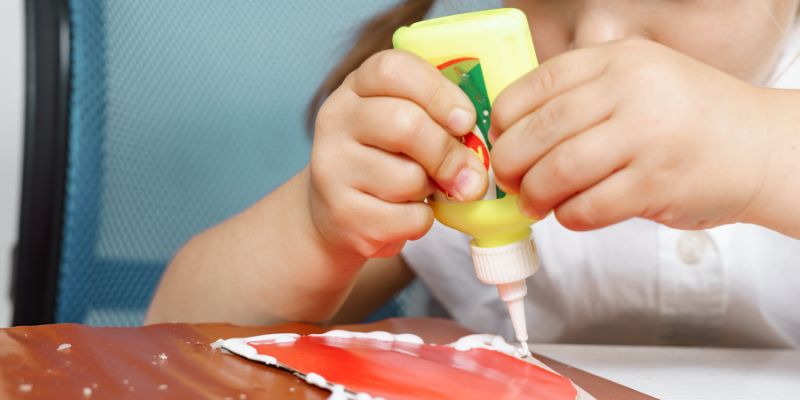Wood glue is not toxic and is generally considered safe for use in woodworking projects. Made from water and a polymer called polyvinyl acetate, wood glue bonds wood together without emitting harmful fumes or creating a health risk for users.

Credit: www.amazon.com
The Composition Of Wood Glue
When it comes to woodworking projects, one common material used is wood glue, which helps to create strong bonds between pieces of wood. But have you ever wondered about the composition of wood glue and whether it is toxic? In this section, we will delve into the ingredients and chemicals found in wood glue, as well as the potential risks associated with its use.
Ingredients And Chemicals
Wood glue is typically made up of a combination of natural or synthetic polymers, solvents, and additives. While the specific formulation may vary between different brands and types of wood glue, the main ingredients and chemicals commonly found in wood glue include:
- Polyvinyl acetate (PVA) – This is the primary polymer used in wood glue, responsible for its adhesive properties. PVA is often derived from petroleum or natural gas.
- Solvents – Wood glue may contain solvents such as water, ethanol, or acetone. These solvents help to reduce the viscosity of the glue, making it easier to apply.
- Additives – Various additives may be included in wood glue to improve its performance and longevity. Examples of additives include preservatives to prevent mold or bacteria growth and fillers to enhance the strength of the adhesive bond.
Potential Risks
While wood glue is generally safe to use when used as directed, it is important to be aware of the potential risks associated with its ingredients and chemicals. Here are some key points to consider:
- Toxicity – Most wood glues are considered non-toxic when dry, but it is important to avoid ingestion or prolonged skin contact with wet glue, as it may cause irritation or allergic reactions.
- Volatile Organic Compounds (VOCs) – Some wood glues may release VOCs during the drying process, which can contribute to indoor air pollution. When using wood glue in confined spaces, adequate ventilation is recommended to minimize exposure.
- Environmental Impact – Wood glue can have a negative impact on the environment if not disposed of properly. Some wood glues may contain chemicals that are harmful to aquatic life, so it is important to follow local regulations for disposal.
Overall, while wood glue does contain ingredients and chemicals that may pose potential risks, using it responsibly and following safety guidelines can help mitigate any adverse effects. Always read and follow the instructions provided by the manufacturer and take appropriate safety measures to ensure a safe woodworking experience.
Health Effects Of Wood Glue
Wood glue is a commonly used adhesive in various woodworking projects. While it is essential for creating strong bonds between pieces of wood, there are important considerations to be aware of regarding its potential health effects. Inhalation risks as well as the possibility of skin contact and absorption are the primary concerns when working with wood glue.
Inhalation Risks
When wood glue is applied and dries, it releases potentially harmful fumes into the air. These fumes, known as volatile organic compounds (VOCs), can be inhaled during the application and drying process. Inhalation of these VOCs can lead to respiratory irritation and discomfort.
Long-term exposure to high concentrations of VOCs can have more severe health effects, including headaches, dizziness, and in some cases, damage to the liver, kidneys, and central nervous system. Therefore, it is crucial to work in a well-ventilated area, using proper respiratory protection such as a mask or respirator, to minimize the risk of inhaling these fumes.
Skin Contact And Absorption
Another potential concern when working with wood glue is direct skin contact and absorption. Wood glue typically contains chemicals that can irritate the skin and cause contact dermatitis. Prolonged or repeated contact with the glue can lead to redness, itching, and skin inflammation.
To minimize the risk of skin contact and absorption, it is important to use protective gloves when handling wood glue. Additionally, if any glue comes into contact with the skin, it should be promptly washed away with soap and water. Applying a barrier cream or lotion before working with wood glue can also provide an added layer of protection.
It is worth noting that different wood glue formulations may contain varying levels of toxic chemicals, so it’s essential to carefully read and follow the manufacturer’s instructions and safety guidelines.
Safety Measures And Best Practices
When working with wood glue, it is essential to prioritize safety measures and best practices to ensure a safe working environment. Implementing these precautions can help minimize potential risks and ensure a smooth and secure woodworking process.
Ventilation And Air Quality
Proper ventilation is crucial when working with wood glue to prevent the accumulation of noxious fumes. Ensure that the workspace is well-ventilated to disperse any airborne fumes effectively. Consider using fans or opening windows to maintain adequate airflow and promote good air quality.
Protective Gear And Precautions
Wearing protective gear is imperative when handling wood glue. Invest in a pair of gloves to protect your skin from direct contact with the adhesive, as it may contain harmful substances. Additionally, using a dust mask or respirator can help prevent inhalation of any potentially hazardous particles during the woodworking process.
Alternatives To Traditional Wood Glue
When it comes to woodworking projects, choosing the right adhesive is important not only for strong and durable bonds but also for the safety of your health and the environment. Traditional wood glue, often made from synthetic chemicals, can contain toxic substances that can be harmful to both humans and the ecosystem.
Natural Glue Options
Thankfully, there are several natural alternatives to traditional wood glue that can provide strong and reliable adhesion without harmful toxins. Below are some eco-friendly options:
- Hide Glue: Made from animal collagen, hide glue has been used for centuries in woodworking. It provides a strong bond and is reversible, allowing for easy disassembly if needed.
- Plant-Based Glues: Some plant-based glues, such as soy-based adhesives, are non-toxic and biodegradable. They offer excellent bonding strength and are a great eco-friendly choice.
Water-based Adhesives
If you’re looking for a non-toxic and easy-to-clean option, water-based adhesives are a great choice. These adhesives are made from a mixture of water and polymers, providing strong bonding with minimal environmental impact.
Water-based adhesives often come in the form of white or yellow glue, which is commonly used in woodworking projects. They work well with porous materials and can be easily cleaned up with water.
Another popular water-based adhesive is the polyvinyl acetate (PVA) glue. PVA glue is known for its strong bond and versatility, making it suitable for various woodworking applications.
When using water-based adhesives, make sure to follow the manufacturer’s instructions for optimal bonding. Some may require clamping or longer drying times to ensure a strong and durable bond.
In conclusion, when it comes to woodworking projects, choosing alternatives to traditional wood glue that are non-toxic and eco-friendly is crucial. Natural glues such as hide glue and plant-based adhesives, as well as water-based options like white glue and PVA glue, offer reliable bonding without compromising your health or the environment.
Environmental Impact Of Wood Glue
When it comes to considering the environmental impact of wood glue, it is essential to take into account various factors such as disposal, recycling, and sustainability concerns. Understanding these aspects can help us make more informed choices about the products we use in our woodworking projects.
Disposal And Recycling
Disposing of wood glue properly is crucial to minimizing its environmental impact. Most types of wood glue are non-toxic once dry, but this does not mean they can be disposed of in the regular trash. Some wood glues contain chemicals that can harm the environment if not disposed of correctly.
To dispose of wood glue, check with your local waste management authority for specific instructions. In many cases, it is best to wait for the glue to dry completely, scrape it off surfaces, and then dispose of it with other solid waste. Avoid pouring liquid glue down sinks or drains as it can contaminate wastewater systems.
Recycling wood glue containers can also help reduce environmental impact. Check if your local recycling program accepts plastic or metal glue bottles. Cleaning out the container thoroughly before recycling is necessary, as residual glue can contaminate the recycling process.
Sustainability Concerns
Sustainability is a growing concern in the woodworking industry, and this extends to the materials and products we use, including wood glue. Here are a few key aspects to consider:
- The source of the materials used in wood glue production: Opting for glues made from sustainably harvested wood or plant-based materials can help reduce the environmental impact.
- The manufacturing process: Some wood glues are manufactured using energy-intensive processes or with harmful chemicals. Choosing glues that prioritize energy efficiency and use less toxic substances can contribute to sustainability efforts.
- The packaging: Look for wood glues that come in minimal and recyclable packaging to minimize waste.
By considering these sustainability concerns when selecting wood glues, we can contribute to promoting a more environmentally friendly woodworking industry.

Frequently Asked Questions For Is Wood Glue Toxic
What Are The Dangers Of Wood Glue?
Wood glue can emit harmful fumes, leading to respiratory issues. Skin irritation may occur when it comes into contact. Ingestion or inhalation can cause nausea and dizziness. Handling wood glue in a well-ventilated area and using protective equipment is crucial to minimize risks.
Is Titebond Wood Glue Non-Toxic?
Yes, Titebond wood glue is non-toxic.
Is Wood Glue Food Safe When Dry?
Yes, wood glue is food-safe when it is fully dry. It is non-toxic and safe to use on surfaces that come into contact with food.
Is Gorilla Wood Glue Non-Toxic?
Yes, Gorilla Wood Glue is non-toxic, making it safe for most applications.
Conclusion
Wood glue can release harmful fumes, so proper ventilation is crucial. It’s important to check the product label and choose non-toxic options for safety. Keep in mind that prolonged exposure can pose health risks, so use caution when working with wood glue.
Overall, being aware of the potential toxicity and taking proper precautions is essential for a safe woodworking experience.


